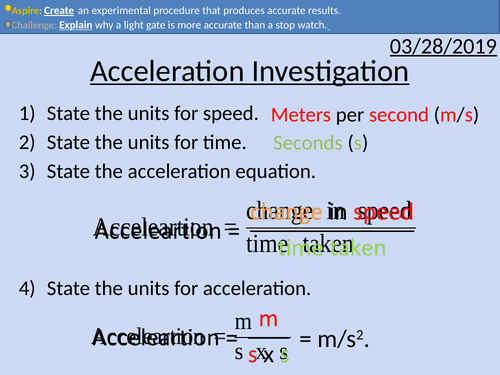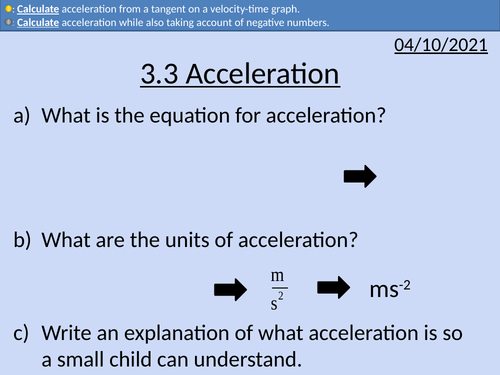497Uploads
167k+Views
71k+Downloads
All resources

GCSE Physics: Scientific Defintions and Speed Experiment
This PowerPoint presentation with worked examples and student questions covers:
• Definitions of accurate and precise
• Definition of resolution
• Definition of repeatable and reproducible
• Planning an experiment for determining speed

GCSE Physics: The Acceleration Equation
This PowerPoint presentation with worked examples and student questions covers:
• Acceleration equation with units
• Speed-time graphs

GCSE Physics: Acceleration - Planning an Experiment
This PowerPoint presentation with worked examples and student questions covers:
Choosing equipment with higher resolution
Planning an experiment to determine acceleration

GCSE Physics: Forces and Vectors
This PowerPoint presentation with worked examples and student questions covers:
Vector addition in 1D
Vector addition in 2D
Resolving vectors

GCSE Physics: Forces and Large Acclerations
This PowerPoint presentation with worked examples and student questions covers:
Road safety
Force and acceleration equations
How large forces produce dangerous accelerations

GCSE Physics: Energy Resources
This presentation covers OCR Gateway Physics 9-1 P8.2.2 Energy Resources
This PowerPoint is a whole lessons included with student activities and animated answers.
How use of energy resources have changed over time. (Biofuels, Fossil Fuels, Nuclear, Renewable).
How energy use has increased (increase population and development of technology)
Explain patterns and trends in the use of energy resources.
Fossil fuels are finite and will run out at current consumption levels.

GCSE Physics: Satellites
This presentation covers OCR Gateway Physics 9-1 P8.3.3 Satellites
This PowerPoint is a whole lessons included with student activities and animated answers.
Natural Satellites
Geostationary Satellites
Low Polar Orbit Satellites
Speed is constant and velocity is changing in stable orbits.
Changing speed and radius
Gravitational force, acceleration, and speed.
Plotting data and describing relationships

OCR AS level Physics: Moving Charges
OCR AS level Physics: Moving Charges is a part of the Module 4: Electrons, Waves, and Photons.
Presentation come with worked examples, solutions and homeworks.
Structure of a metal
Conventional current and electron flow
Measuring current with an ammeter
Ionic solutions with cations and anions.
Ions, relative charge and absolute charge
Comparing ionic solutions and metal conductors

OCR AS level Physics: Resolving Vectors
OCR AS level Physics: Resolving Vectors is a part of the Module 2: Foundations of Physics
Full lesson PowerPoint with worked examples and homework with complete worked answers.
Using trigonometry to solve vector problems
Vectors in 2 D
Resolving vectors on a slope

OCR AS level Physics: Adding Vectors
OCR AS level Physics: Adding Vectors is a part of the Module 2: Foundations of Physics
Full lesson PowerPoint with worked examples and homework with complete worked answers.
Adding vectors in 1 D
Adding vectors in 2 D
Vector triangles
Using Pythagoras’ theorem to determine the magnitude
Using trigonometry to determine the direction

OCR AS level Physics: Acceleration
OCR AS level Physics: Acceleration is a part of the Module 3: Forces and Motion
Presentation come with worked examples, solutions and homeworks.

OCR AS level Physics: Conservation of Energy
OCR AS level Physics: Conservation of Energy is a part of the Module 3: Work, Energy and Power.
Presentation come with worked examples, solutions and homeworks.

OCR AS level Physics: Work Done and Energy
OCR AS level Physics: Work Done and Energy is a part of the Module 3: Work, Energy and Power.
Presentation come with worked examples, solutions and homeworks.

OCR AS level Physics: Kinetic and Gravitational Potential Energy
OCR AS level Physics: Kinetic and Gravitational Potential Energy is a part of the Module 3: Work, Energy and Power.
Presentation come with worked examples, solutions and homeworks.

OCR AS level Physics: Einstein's Photoelectric Equation
OCR AS level Physics: Einstein’s Photoelectric Effect Equation is a part of the Module 4: Electrons, Waves, and Photons.
Full lesson PowerPoint with worked examples and homework with complete worked answers.
The photoelectric equation
Work function and Kinetic Energy
Determining work function from a graph
Determining threshold frequency from a from graphical analysis.
Determining Plank’s constant from graphical analysis.

GCSE Chemistry: Atomic Structure
This PowerPoint presentation with worked examples and student questions covers:
• Scientific models as a concept
• Structure of the atom
• Relative mass and charge of subatomic particles
• Bond length of atoms and molecules

GCSE Chemistry: Development of the Atomic Model
This PowerPoint presentation with worked examples and student questions covers:
• Dalton, Thomson, Rutherford and Bohr’s models
• Comparing different scientific models of the atom

OCR Applied Science: 1.3 Ionic and Covalent Bonding
This PowerPoint presentation with worked examples and student activities covers:
Topic 1.3 of Science Fundementals of the OCR Applied Science Spec.
Elements react together to form compounds by i.e.
ionic bonding
covalent bonding

OCR Applied Science: 4.2 Polymers and Carbon Compounds
This PowerPoint presentation with worked examples and student activities covers:
Topic 4.2 of Module 1: Science Fundamentals of the OCR Applied Science Spec.
Determining the empirical formula for compounds
Draw monomers and repeat units using structural and skeletal formula of the following polymers:
Polyethene
Polypropene
Polylactate
Polystyrene
Polyvinyl chloride (PVC)

OCR Applied Science: 4.1 Principles of Carbon Chemistry
This PowerPoint presentation with worked examples and student activities covers:
Topic 4.1 of Module 1: Science Fundamentals of the OCR Applied Science Spec.
• Alkanes as saturated hydrocarbons containing single C-C and C-H bonds
• Alkenes as unsaturated hydrocarbons containing a C=C double bond
• Alkynes as unsaturated hydrocarbons containing a C ≡ C triple bond
• Name and draw structural and skeletal formulae of the first four members of alkanes, alkenes and alkynes
• Aldehydes and ketones as organic compounds containing the C=O group
• Name and draw the structural formulae of the first four aldehydes and the first two ketones
• Alcohols as organic compounds containing the OH group
• Name and draw structural and skeletal formulae of the first four alcohols
• Conversion of alcohols to form aldehydes and ketones is classified as an oxidation reaction
• Name and draw structural and skeletal formulae of the first four carboxylic acids
• Reaction of carboxylic acids with an alkali, to include full equations using structural formulae
• Name and draw structural and skeletal formulae of the four C4H8O2 esters
• How an ester can be made from a carboxylic acid and an alcohol




















